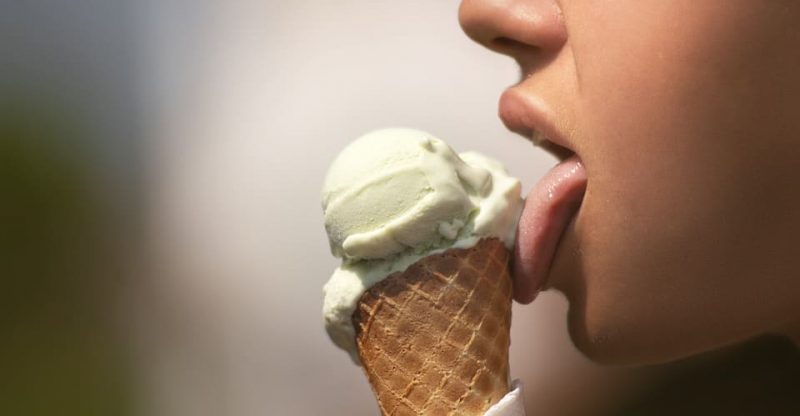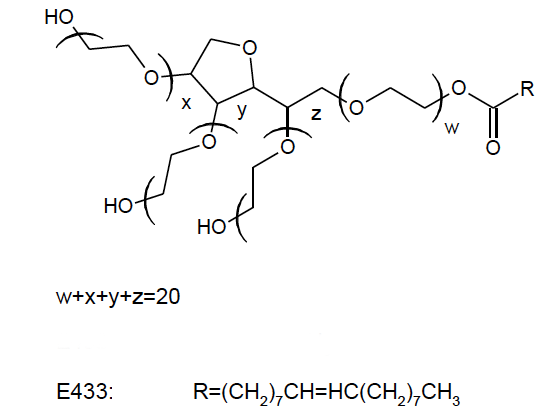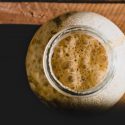What is Tween 80/Polysorbate 80 (E433) in Food? Uses, Safety, Side effects

Meaning of 80 and 20 | Production | Uses | Safety | Side effects | FAQs
Polysorbate 80, or Tween 80, is the abbreviation of “polyoxyethylene (20) sorbitan monooleate”, is a nonionic surfactant and emulsifier commonly used in food (with the European food additive number E433) and cosmetics mainly due to its ability to mix water-based and oil-based ingredients well (with a high approximate HLB value 15).
What are 80 (after polysorbate) and 20 (following polyoxyethylene) stands for?
- 80 refers to the type of fatty acid attached to the polyoxyethylene sorbitan part of the molecule, here it is monooleate or oleic acid.
- 20 means the total number of oxyethylene –(CH2CH2O)–groups in the molecule.
How is Polysorbate 80 made?
Polysorbates (20,40, 60, 65, 80) are the ethoxylated sorbitan esters which are manufactured by the reaction among sorbitol, a specific fatty acid, and ethylene oxide (an average of 20 polymerized ethylene oxide per molecule of polysorbate 80).
The fatty acid used for the production of polysorbate 80 is oleic acid.
Let’s see its two raw materials.
Sorbitol
It is a sugar alcohol produced by the reduction reaction (or hydrogenation) of glucose which is obtained from maize or tapioca starch. Know more Sorbitol here.
Oleic Acid
Oleic acid is a monounsaturated fatty acid naturally found in animal fats & oils and vegetable oils. Commercial food grade oleic acid is not pure and is a mixture of several fatty acids.
Like other fatty acids, oleic acid also present in nature commonly in the form of triglycerides. The following are the vegetable oils high with oleic acid (1):
- Olive oil (2)
- Pecan oil
- Canola oil
- Peanut oil
- Macadamia oil
- Sunflower oil
- Grape seed oil
- Sea buckthorn oil
- Sesame oil
- Poppyseed oil
Manufacturing process
According to the FDA, there are generally two steps in the manufacturing process of polysorbate 80 (3):
- Esterification between oleic acid and sorbitol to obtain sorbitan esters.
- Condensation sorbitan esters with ethylene oxide.
Polysorbate 80 can also be produced by reacting sorbitol and ethylene oxide first then esterified with oleic acid, the following are the brief flow chart (4):
- Obtaining the mixture of sorbitol and sorbitan by partially dehydrating sorbitol.
- Adding ethylene oxide to the mixture to obtain sorbitan polyethylene ether.
- Reacting it with oleic acid.
Specification
| Other Names |
|
| CAS Number | 9005-65-6 |
| Chemical formula | C64H124O26 |
| Molecular Weight | 1310 |
Structure

Image Source
- Hydrophilic groups: polyoxyethylene groups, which are polymers of ethylene oxide
- Lipophilic group: oleic acid
Properties
Appearance
A viscous, lemon to amber-colored oily liquid at 25°C.
Hydrophilic – Lipophilic Balance (HLB)
15, gives oil-in-water emulsions, O/W
Viscosity
It is also a viscosity agent with the viscosity 300–500 centistokes (@25°C).
Solubility
In Water
Soluble in water due to the long polyoxyethylene chains.
In Organic Solvents
Soluble in most solvents, such as ethanol, methanol, ethyl acetate and toluene.
What’re the Uses of Polysorbate 80?
Polysorbate 80 is a super emulsifier and stabilizer that mixes two or more not compatible ingredients not separate, usually oil and water. Commonly used in food and cosmetics, also with a little application in medicines, vaccines and others.
Food
Food grade Polysorbate 80 helps water-based liquids and oils-based ingredients mixed together easily. Its common food applications are in ice cream, pickles, vitamins and sauce.
Let’s see its various functions in food.
Ice cream
- Provide a creamy texture
- Hold fat and water together (or maintain the shape) very well
- Prevent ice crystals formation
- Make ice cream resistant to melt
Pickles
As a solubilizer to disperse food flavors and colors.
Vitamin supplements
As a solubilizing and dispersing agent in fat-soluble vitamins and vitamin-mineral preparations.
Butter sauce
Polysorbate 80 produces the creamy sauce; enables butter and water not separate; makes the milk solids, salts, flavors, colors and other ingredients distributed evenly in the sauce.
Cosmetics
Cosmetic grade polysorbate 80 functions as a denaturant, emulsifying, surfactant (5) in cosmetics and personal care products to help blend oil and water.
For the strong hydrophilicity, it can distribute colors (e.g. incorporate mica), fragrances, oils and other ingredients evenly in bath bombs, creams and soaps.
The following products may contain polysorbate 80:
- Bath bombs
- Shampoo
- Body butter
- Soap
Pharmaceutical
EP/USP/NF grade polysorbate 80 can be used as an excipient that acts as an emulsifier, solubilizing agent or suspension stabilizer in various pharmaceutical formulations, such as in the dosage forms of solid, semi-solid and liquid. (6)
Others
Polysorbate 80 can be used as an emulsifier and stabilizer in various vaccines (7), as a lubricant in eye drops. (8)
Is Polysorbate 80 Safe to Eat?
Yes, it has been approved as a safe ingredient by the U.S. Food and Drug Administration (FDA) and European Food Safety Authority (EFSA), as well as the Joint FAO/WHO Expert Committee on Food Additives (JECFA).
FDA
Polysorbate 80 is a multifunctional ingredient that may be safely used in food as an emulsifier, defoamer, solubilizing and dispersing agent, surfactant, wetting agent and adjuvant.
The following food may contain it and with the maximum use levels (9):
- Ice cream 0.1%
- Yeast defoamer 4ppm
- Pickles and pickled products 500 ppm
- Vitamin preparations, the maximum intake of polysorbate 80 per day 175-475 milligrams
- Shortenings and edible oils 1% (with polysorbate 60 or not)
- cottage cheese 0.008%
- Whipped edible oil topping 0.4% with/not sorbitan monostearate/polysorbate 60/polysorbate 65
- Gelatin desserts and mixes 0.082%
- Barbecue sauce 0.005%
EFSA
Polyoxyethylene sorbitan monooleate (E433) is listed in Commission Regulation (EU) No 231/2012 as an authorised food additive and categorized in “Additives other than colours and sweeteners” (10).
Approved uses
Its application is listed together with other polysorbates: polysorbate 20 (E432), 40(E434), 60(E435), 65(E436), with the maximum usages 500-1000mg/kg. Its usage is “quantum satis” in power or liquid food supplements (not for infants and young children). The following food may contain it (11):
- Flavoured fermented milk products
- Milk and cream analogues
- Fat emulsions for baking
- Sugar confectionery
- Chewing gum
- Decorations, coatings and fillings
- Fine bakery wares
- Soups, sauces
- Desserts
Safety re-evaluation in 2018
After the studies of genotoxicity, carcinogenicity & developmental toxicity and other safety researches, EFSA established the ADI of 25mg/kg bw/day. (12)
UK Food Standards Agency
Categorized in “Others” (13)
Food Standards Australia New Zealand
It is an approved ingredient in Australia and New Zealand with the code number 433. (14)
JECFA
Function Class: food additives, emulsifier. (15)
Acceptable daily intake: ADI “0-25mg/kg bw” set in 1973. (16)
What are the possible Side Effects of Polysorbate 80?
It is generally safe but has some possible side effects around it:
- Blood brain barrier disruption
- Two carcinogens: ethylene oxide and 1,4-dioxane
- Some allergic symptoms
Blood brain barrier disruption
Blood brain barrier is a barrier between the brain’s blood vessels and the cells and other components that make up brain tissue (17). It protects our brain by allowing some materials to cross, while preventing foreign substances, such as pathogens, toxins and others from going into.
A study in mice in 2005 found that blood-brain barrier disruption may be caused at a dose of polysorbate 80 of 3-30 mg/kg. (18)
Scientists use this principle to enhance the delivery of drugs from blood to the brain. (19)
Ethylene Oxide
Consumers may be afraid of the dangers of ethylene oxide as it is classified as “carcinogenic to humans” (Group 1) (20). However, it is safe as the assay of this impurity is very low in the food grade polysorbate 80, less than 0.2 mg/kg. (21)
1,4-dioxane
1,4-dioxane is classified as “possibly carcinogenic to humans” (Group 2B) (22). 1,4-dioxane is no toxicological concern as the low use levels of polysorbate 80 in food and the content of 1,4-dioxane is less than 5 mg/kg. (23)
Allergy
In early studies from 1976-2005 summarized by EFSA that polysorbate 80 may cause the following allergy symptoms (24):
- Anaphylactoid reactions
- Hypersensitivity reactions
- Immunological contact urticaria
- Dermatitis
Other possible adverse effects
A 2015 study found polysorbate 80 and carboxymethylcellulose (sodium CMC)might be associated with gut inflammation. (25)
Frequently asked questions of Polysorbate 80
Is it Natural?
No, it is a synthetic ingredient made from chemical synthesis as mentioned above.
What is it made of?
It is a mixture of polyoxyethylene ethers of mixed partial oleic acid esters of sorbitol and its mono- and dianhydrides and related compounds. (26)
Is it Halal?
Yes, polysorbate 80 would be halal if the fatty acid oleic acid is sourced from vegetable oils.
Is It Gluten free?
Yes, polysorbate 80 is gluten free as it does not contain wheat, rye, barley, or crossbreeds of these grains. And can be used for people with celiac disease.
Is It Vegan?
Yes, it is vegan if the fatty acid – oleic acid derived from vegetable oils as no animal matter or products derived from animal used in the production. So it is suitable to add in the diet of vegetarians.
But some manufacturing process may use oleic acid from animal fats/oils. Therefore, vegetarians should avoid it.
Conclusion
Now you may have a knowledge of the emulsifier – Tween 80/Polysorbate 80 (E433), from the following aspects:
- Two production process: esterification of sorbitol and oleic acid first then condensed with ethylene oxide OR the firstly react the mixture of sorbitol and sorbitan with ethylene oxide.
- Uses and functions in food: ice cream, pickles, vitamins, sauce. Also in cosmetics, pharmaceuticals and so on.
- Safety
- Possible side effects
- FAQs: is it natural, halal, gluten free, vegan and so on
I’m probably forgetting some information of polysorbate 80, and if you have any questions or remarks about this additive, feel free to let me know in the comments.



I am one of those allergic to polysorbate 80. I also am gluten intolerant. I’m wondering if the polysorbate may have caused my gluten intolerance?
Me too. Also to Polyethylene glycol. It has meant I have been refused the COVID19 vaccines – so far all of them use one or the other ingredient.
Hi Hammer,
Your gluten intolerance may not caused by polysorbate 80.
I find it interesting that the 80 designation of PS80 has no obvious relation to the chemical name Polyoxyethylene (20) sorbitan monooleate.
This is the only hit for polyethylene glycol on your site.
However, surely mono, di and triglycerides of fatty acids also contain PEG?
There needs to be a lot more clarity about it’s use (over 100 names for pity sake!). I can see this happening as my PEG allergy group has been swamped with new members recently. It’s still a rare allergy, but nowhere near as rare as it was before this.
Please lead the fight – we’re all really struggling to figure out what’s safe to eat!
It’s (E433) not halal if not mentioned the source. So Muslims must avoid it in any circumstances unless mentioned vegetable source or halal.
Polysorbate 80 is also used in the delivery of several chemotherapy drugs. I was recently given Docetaxel and had an anaphylactic reaction to it even though they gave me the routine pre-meds for possible reactions. Polysorbate 80 was added to my chart as an allergy and my doctor recommended even avoiding Ibuprofen in the future because it contains P-80. So be sure to check your medications and vitamins if you’re concerned about this chemical 😃
very interesting stuff. I am over the pond in the uk and cannot find food grade polysorbate to make ice cream. All sellers say they cannot say it is food grade as they don’t have a food licence. I am wondering what the difference between the two are?